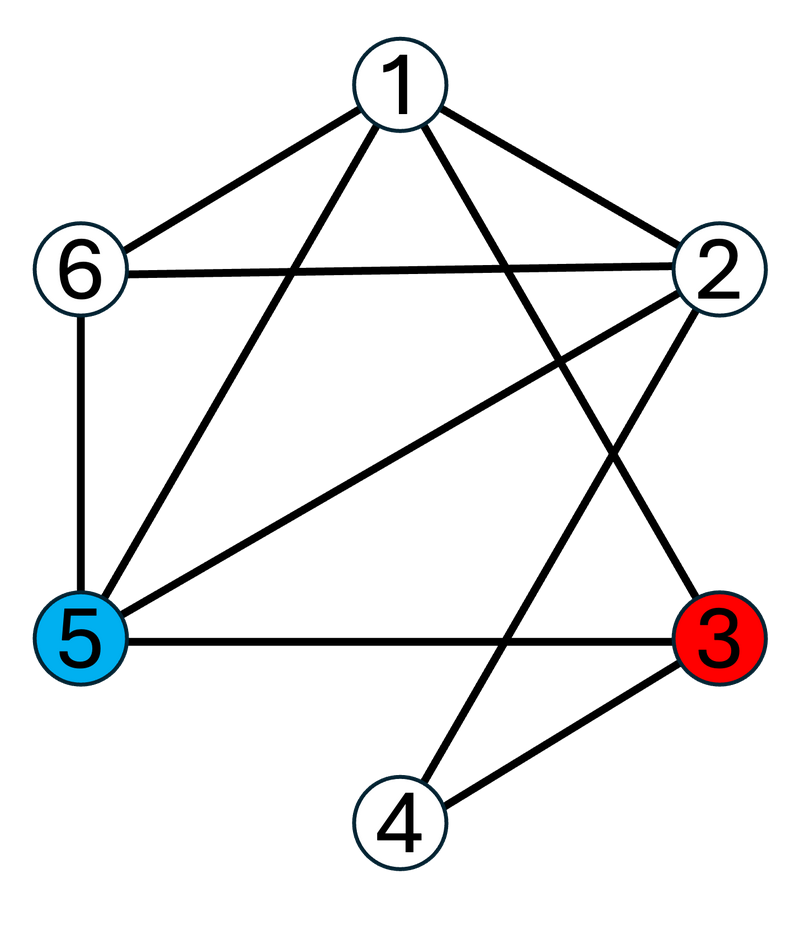Problem Statement
You are given a simple connected undirected graph?G?with?N?vertices and?M?edges.
The vertices of?G?are numbered vertex?1, vertex?2,?…, vertex?N, and the?i-th?(1≤i≤M)?edge connects vertices?Ui??and?Vi?.Find the lexicographically smallest simple path from vertex?X?to vertex?Y?in?G.
That is, find the lexicographically smallest among the integer sequences?P=(P1?,P2?,…,P∣P∣?)?that satisfy the following conditions:
1≤Pi?≤N
If?i
j, then?Pi?
Pj?.
P1?=X?and?
For?1≤i≤∣P∣?1, there exists an edge connecting vertices?Pi??and?Pi+1?.
One can prove that such a path always exists under the constraints of this problem.
You are given?T?test cases, so find the answer for each.
Lexicographic order on integer sequencesAn integer sequence?S=(S1?,S2?,…,S∣S∣?)?is lexicographically smaller than an integer sequence?T=(T1?,T2?,…,T∣T∣?)?if either of the following 1. or 2. holds. Here,?∣S∣?and?∣T∣?represent the lengths of?S?and?T, respectively.
∣S∣<∣T∣?and?(S1?,S2?,…,S∣S∣?)=(T1?,T2?,…,T∣S∣?).
There exists some?1≤i≤min(∣S∣,∣T∣)?such that?(S1?,S2?,…,Si?1?)=(T1?,T2?,…,Ti?1?)?and?Si?<Ti?.
Constraints
1≤T≤500
2≤N≤1000
N?1≤M≤min(2N(N?1)?,5×104)
1≤X,Y≤N
X
Y
1≤Ui?<Vi?≤N
If?i
j, then?(Ui?,Vi?)
(Uj?,Vj?).
The given graph is connected.
The sum of?N?over all test cases in each input is at most?1000.
The sum of?M?over all test cases in each input is at most?5×104.
All input values are integers.
Input
The input is given from Standard Input in the following format:
T
case1?
case2?
?
caseT?casei??represents the?i-th test case. Each test case is given in the following format:
N M X Y
U1? V1?
U2? V2?
?
UM? VM?Output
Output?T?lines.
The?i-th line?(1≤i≤T)?should contain the vertex numbers on the simple path that is the answer to the?i-th test case, in order, separated by spaces.
That is, when the answer to the?i-th test case is?P=(P1?,P2?,…,P∣P∣?), output?P1?,?P2?,?…,?P∣P∣??on the?i-th line in this order, separated by spaces.
Sample Input 1
2
6 10 3 5
1 2
1 3
1 5
1 6
2 4
2 5
2 6
3 4
3 5
5 6
3 2 3 2
1 3
2 3Sample Output 1
3 1 2 5
3 2For the first test case, graph?G?is as follows:
The simple paths from vertex?3?to vertex?5?on?G, listed in lexicographic order, are as follows:
- (3,1,2,5)
- (3,1,2,6,5)
- (3,1,5)
- (3,1,6,2,5)
- (3,1,6,5)
- (3,4,2,1,5)
- (3,4,2,1,6,5)
- (3,4,2,5)
- (3,4,2,6,1,5)
- (3,4,2,6,5)
- (3,5)
Among these, the lexicographically smallest is?(3,1,2,5), so output?3,1,2,5?separated by spaces on the first line.
For the second test case,?(3,2)?is the only simple path from vertex?3?to vertex?2.
題目大意:找到從x到y的最小字典序通路
用鄰接圖存儲,排序,dfs搜索,回溯,注意回溯的時候,不用把狀態再改回false,因為我們在dfs到該點時,已經發現它是構不成連通的,所以下次就不需要再到達這個節點了,這樣可以減少很大一部分運算,從而將TLE的代碼變成AC
AC代碼:
#include<bits/stdc++.h>
using namespace std;
using ll=long long;
const ll N=200010;
int n,m,x,y;
vector<int>path;
bool found;
void dfs(int current,vector<vector<int>>&graph,vector<bool>&visit){path.push_back(current);visit[current]=true;if (current==y){found=true;for (int i:path) cout<<i<<" ";cout<<"\n";return ; }sort(graph[current].begin(),graph[current].end());for (auto i:graph[current]){if (!visit[i]&&!found){visit[i]=true;dfs(i,graph,visit);if (found)return ;path.pop_back();}}
}
void solve(){cin>>n>>m>>x>>y;vector<vector<int>>graph(n+1);for (int i=1;i<=m;i++){int u,v;cin>>u>>v;graph[u].push_back(v);graph[v].push_back(u);}path.clear();vector<bool>visit(n+1,false);found=false;dfs(x,graph,visit);
}
int main() {ios::sync_with_stdio(0);cin.tie(0);cout.tie(0);int T;cin>>T;while(T--){solve();}
}






)


)
)


:3天制作Galgame引擎《Galplayer》——無敵之道心)



)

)